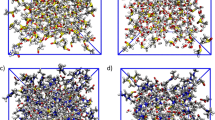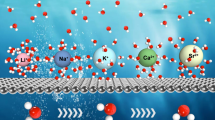Abstract
The structures of water inside and outside (6,6), (8,8), and (10,10) singlewalled carbon nanotubes (SWCNTs) under an electric field perpendicular to the tube axis are investigated by molecular dynamics simulations. The results show that dipole reorientation induced by electric field plays a significant role on the structures of confined water inside and outside SWCNTs. Inside SWCNTs, the average water occupancy and the average number of hydrogen bonds (H-bonds) per water molecule decrease as the electric intensity increases. Because the field intensity is sufficiently strong, the initial water structures inside the SWCNTs are destroyed, and the isolated water clusters are found. Outside SWCNTs, the azimuthal distributions of the density and the average number of H-bonds per water molecule around the solid walls become more and more asymmetric as the electric intensity increases. The percentages of water molecules involved in 0-5 H-bonds for all the three types of SWCNTs under different field intensities are displayed. The results show that those water molecules involved with most H-bonds are the most important to hold the original structures. When the electric field direction is parallel with the original preferred orientation, the density and the H-bond connections in water will be increased; when the electric field direction is perpendicular to the original preferred orientation, the density and the H-bond connections in water will be decreased.
Similar content being viewed by others
References
Whitby, M. and Quirke, N. Fluid flow in carbon nanotubes and nanopipes. Nature Nanotechnology, 2(2), 87–94 (2007)
Holt, J. K., Park, H. G., Wang, Y., Stadermann, M., Artyukhin, A. B., Grigoropoulos, C. P., Noy, A., and Bakajin, O. Fast mass transport through sub-2-nanometer carbon nanotubes. Science, 312(5776), 1034–1037 (2006)
Ghosh, S., Sood, A. K., and Kumar, N. Carbon nanotube flow sensors. Science, 299(5609), 1042–1044 (2003)
Siwy, Z. and Fuliński, A. Fabrication of a synthetic nanopore ion pump. Physical Review Letters, 89(19), 198103 (2002)
Zhu, F. and Schulten, K. Water and proton conduction through carbon nanotubes as models for biological channels. Biophysical Journal, 85(1), 236–244 (2003)
Gong, X. J., Li, J. Y., Lu, H. J., Wan, R. Z., Li, J. C., Hu, J., and Fang, H. P. A charge-driven molecular water pump. Nature Nanotechnology, 2(11), 709–712 (2007)
Hummer, G., Rasaiah, J. C., and Noworyta, J. P. Water conduction through the hydrophobic channel of a carbon nanotube. nature, 414(6860), 188–190 (2001)
Walther, J. H., Jaffe, R., Halicioglu, T., and Koumoutsakos, P. Carbon nanotubes in water: structural characteristics and energetics. The Journal of Physical Chemistry B, 105(41), 9980–9987 (2001)
Koga, K., Gao, G. T., Tanaka, H., and Zeng, X. C. Formation of ordered ice nanotubes inside carbon nanotubes. nature, 412(6849), 802–805 (2001)
Wang, J., Zhu, Y., Zhou, J., and Lu, X. H. Diameter and helicity effects on static properties of water molecules confined in carbon nanotubes. Physical Chemistry Chemical Physics, 6(4), 829–835 (2004)
Zhou, X. Y. and Lu, H. J. The structure and dynamics of water inside armchair carbon nanotube. Chinese Physics B, 16(2), 335–339 (2007)
Alexiadis, A. and Kassinos, S. Influence of water model and nanotube rigidity on the density of water in carbon nanotubes. Chemical Engineering Science, 63(10), 2793–2797 (2008)
Thomas, J. A. and McGaughey, A. J. H. Density, distribution, and orientation of water molecules inside and outside carbon nanotubes. Journal of Chemical Physics, 128(8), 084715 (2008)
Alexiadis, A. and Kassinos, S. Molecular simulation of water in carbon nanotubes. Chemical Reviews, 108(12), 5014–5034 (2008)
Fang, H. P., Wan, R. Z., Gong, X. J., Lu, H. J., and Li, S. Y. Dynamics of single-file water chains inside nanoscale channels: physics, biological significance and applications. Journal of Physics D: Applied Physics, 41(10), 103002 (2008)
Takaiwa, D., Hatano, I., Koga, K., and Tanaka, H. Phase diagram of water in carbon nanotubes. Proceedings of the National Academy of Sciences, 105(1), 39–43 (2008)
Wan, R. Z., Li, J. Y., Lu, H. J., and Fang, H. P. Controllable water channel gating of nanometer dimensions. Journal of the American Chemical Society, 127(19), 7166–7170 (2005)
Huang, B. Distribution patterns and controllable transport of water inside and outside charged single-walled carbon nanotubes. Journal of Chemical Physics, 122(8), 084708 (2005)
Li, J. Y., Gong, X. J., Lu, H. J., Li, D., Fang, H. P., and Zhou, R. H. Electrostatic gating of a nanometer water channel. Proceedings of the National Academy of Sciences, 104(10), 3687–3692 (2007)
Huang, L. L., Zhang, L. Z., Shao, Q., Wang, J., Lu, L. H., Lu, X. H., Jiang, S. Y., and Shen, W. F. Molecular dynamics simulation study of the structural characteristics of water molecules confined in functionalized carbon nanotubes. The Journal of Physical Chemistry B, 110(51), 25761–25768 (2006)
Foroutan, M. and Moshari, M. Molecular dynamics simulations of functionalized carbon nanotubes in water: effects of type and position of functional groups. Physica E: Low-Dimensional Systems and Nanostructures, 43(1), 359–365 (2010)
Vaitheeswaran, S., Rasaiah, J., and Hummer, G. Electric field and temperature effects on water in the narrow nonpolar pores of carbon nanotubes. Journal of Chemical Physics, 121(16), 7955–7965 (2004)
Xu, B., Qiao, Y., Zhou, Q., and Chen, X. Effect of electric field on liquid infiltration into hydrophobic nanopores. Langmuir, 27(10), 6349–6357 (2011)
Fu, Z., Luo, Y., Ma, J., and Wei, G. Phase transition of nanotube-confined water driven by electric field. Journal of Chemical Physics, 134(15), 154507 (2011)
Su, J. Y. and Guo, H. X. Control of unidirectional transport of single-file water molecules through carbon nanotubes in an electric field. ACS Nano, 5(1), 351–359 (2011)
Figueras, L. and Faraudo, J. Competition between hydrogen bonding and electric field in single-file transport of water in carbon nanotubes. Molecular Simulation, 38(1), 23–25 (2011)
Vaitheeswaran, S., Yin, H., and Rasaiah, J. C. Water between plates in the presence of an electric field in an open system. The Journal of Physical Chemistry B, 109(14), 6629–6635 (2005)
England, J. L., Park, S., and Pande, V. S. Theory for an order-driven disruption of the liquid state in water. The Journal of Physical Chemistry B, 128(4), 044503–044508 (2008)
Hess, B., Kutzner, C., van der Spoel, D., and Lindahl, E. GROMACS 4: algorithms for highly efficient, load-balanced, and scalable molecular simulation. Journal of Chemical Theory and Computation, 4(3), 435–447 (2008)
Daub, C. D., Bratko, D., Leung, K., and Luzar, A. Electrowetting at the nanoscale. The Journal of Chemical Physics C, 111(2), 505–509 (2006)
Darden, T., York, D., and Pedersen, L. Particle mesh Ewald: an N-log(N) method for Ewald sums in large systems. Journal of Chemical Physics, 98(12), 10089–10092 (1993)
Wan, R. Z., Lu, H. J., Li, J. Y., Bao, J. D., Hu, J., and Fang, H. P. Concerted orientation induced unidirectional water transport through nanochannels. Physical Chemistry Chemical Physics, 11(42), 9898–9902 (2009)
Suresh, S. J., Satish, A. V., and Choudhary, A. Influence of electric field on the hydrogen bond network of water. Journal of Chemical Physics, 124(7), 074506 (2006)
Walther, J. H., Jaffe, R., Halicioglu, T., and Koumoutsakos, P. Carbon nanotubes in water: structural characteristics and energetics. The Journal of Physical Chemistry B, 105(41), 9980–9987 (2001)
Bratko, D., Daub, C. D., Leung, K., and Luzar, A. Effect of field direction on electrowetting in a nanopore. Journal of the American Chemical Society, 129(9), 2504–2510 (2007)
Author information
Authors and Affiliations
Corresponding author
Additional information
Project supported by the National Natural Science Foundation of China (Nos. 11372175 and 11272197), the Doctoral Fund of Ministry of Education of China (No. 20103108110004), and the Innovation Program of Shanghai Municipality Education Commission (No. 14ZZ095)
Rights and permissions
About this article
Cite this article
Xu, Z., Hu, Gh., Wang, Zl. et al. Water structures inside and outside single-walled carbon nanotubes under perpendicular electric field. Appl. Math. Mech.-Engl. Ed. 35, 1–12 (2014). https://doi.org/10.1007/s10483-014-1767-6
Received:
Revised:
Published:
Issue Date:
DOI: https://doi.org/10.1007/s10483-014-1767-6




